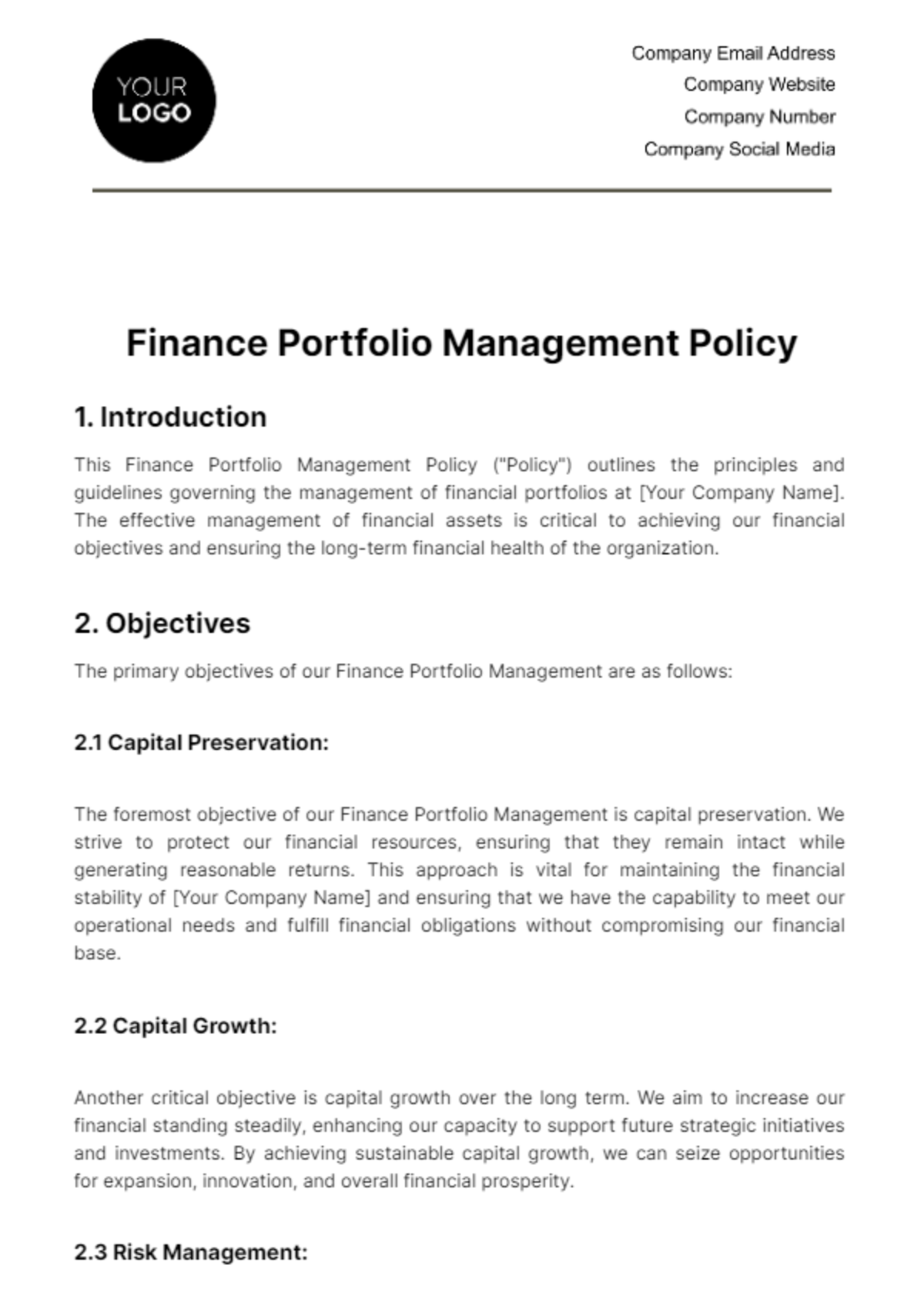Free Finance Portfolio Management Policy

1. Introduction
This Finance Portfolio Management Policy ("Policy") outlines the principles and guidelines governing the management of financial portfolios at [Your Company Name]. The effective management of financial assets is critical to achieving our financial objectives and ensuring the long-term financial health of the organization.
2. Objectives
The primary objectives of our Finance Portfolio Management are as follows:
2.1 Capital Preservation:
The foremost objective of our Finance Portfolio Management is capital preservation. We strive to protect our financial resources, ensuring that they remain intact while generating reasonable returns. This approach is vital for maintaining the financial stability of [Your Company Name] and ensuring that we have the capability to meet our operational needs and fulfill financial obligations without compromising our financial base.
2.2 Capital Growth:
Another critical objective is capital growth over the long term. We aim to increase our financial standing steadily, enhancing our capacity to support future strategic initiatives and investments. By achieving sustainable capital growth, we can seize opportunities for expansion, innovation, and overall financial prosperity.
2.3 Risk Management:
Effective risk management is at the core of our Finance Portfolio Management. We employ diversification strategies across various asset classes to mitigate risk. Furthermore, we adhere to predefined risk tolerance levels and continually monitor the performance of our portfolio to ensure that it aligns with our risk management objectives. This disciplined approach helps safeguard our financial assets.
2.4 Liquidity Management:
Liquidity management is essential to our Finance Portfolio Management. We maintain sufficient liquidity to meet immediate financial needs and contingencies. This ensures that we can address unforeseen circumstances and short-term financial obligations without jeopardizing our long-term investment objectives. It provides us with the flexibility and resilience required to navigate changing financial landscapes effectively.
3. Investment Guidelines
Our Finance Portfolio Management adheres to the following guidelines:
3.1 Asset Allocation
Maintain a diversified portfolio across various asset classes, including equities, fixed income, real estate, and alternative investments, to spread risk effectively.
Regularly review and adjust the asset allocation strategy to align with the changing market conditions and the organization's financial goals.
3.2 Risk Tolerance
Periodically assess risk tolerance to ensure that it remains consistent with the organization's objectives and risk appetite.
Make necessary adjustments to the investment strategy based on risk tolerance assessments.
3.3 Diversification
Diversify investments across sectors, industries, and geographic regions to reduce concentration risk.
Avoid excessive exposure to any single asset or investment type.
3.4 Liquidity Requirements
Maintain a portion of investments in highly liquid assets, such as cash or short-term securities, to cover immediate financial needs and emergencies.
Determine the appropriate liquidity level based on the organization's short-term obligations and cash flow requirements.
4. Investment Strategies
We employ a combination of investment strategies to meet our objectives:
4.1 Passive Investment
Invest in index funds, exchange-traded funds (ETFs), and other passive vehicles to capture market returns cost-effectively.
Passive investments are particularly suitable for asset classes where active management may not provide a significant advantage.
4.2 Active Investment
Engage skilled portfolio managers and investment professionals to actively manage selected portions of the portfolio.
Active strategies are employed where opportunities exist to outperform market benchmarks.
4.3 Ethical Considerations
Avoid investments in companies or industries that conflict with our ethical and sustainability standards.
Ensure investments align with the organization's values and corporate social responsibility principles.
5. Monitoring and Review
Our Finance Portfolio Management includes a robust monitoring and review process:
5.1 Performance Evaluation
Regularly evaluate the performance of the portfolio against predefined benchmarks.
Performance assessments are conducted [Frequency of Review] to determine the effectiveness of the investment strategy.
5.2 Rebalancing
Rebalance the portfolio as needed to maintain the target asset allocation.
Rebalancing decisions are based on deviations from the target allocation exceeding [Threshold Percentage].
5.3 Reporting
Provide stakeholders with comprehensive investment reports on a regular basis, including performance summaries, portfolio composition, and compliance with this Policy.
Reports are distributed [Frequency of Reporting] to ensure transparency and accountability.
6. Responsibilities
The following individuals and committees are responsible for the implementation and oversight of this Policy:
6.1 [Your Company Name]
[Your Company Name] shall establish an Investment Committee responsible for the implementation and monitoring of this Policy. The committee consists of [Number of Committee Members] members with expertise in finance and investments.
6.2 [Your Name]
As the designated [Your Position], I am responsible for overseeing the day-to-day implementation of this Policy, including investment decisions, monitoring, and reporting. Any questions or concerns regarding this Policy should be directed to me.
7. Conclusion
[Your Company Name] is committed to prudent and responsible financial portfolio management. This Finance Portfolio Management Policy serves as a guiding framework for all investment-related decisions and will be reviewed periodically to ensure alignment with the organization's financial objectives and market conditions.
For inquiries or further information, please contact me at [Your Email] or [Your Phone Number].
Sincerely,
[Your Name]
[Your Title]
- 100% Customizable, free editor
- Access 1 Million+ Templates, photo’s & graphics
- Download or share as a template
- Click and replace photos, graphics, text, backgrounds
- Resize, crop, AI write & more
- Access advanced editor
Enhance your financial strategy with Template.net's editable Finance Portfolio Management Policy Template. Craft a comprehensive policy that outlines your investment objectives, guidelines, and strategies with ease using our handy AI Editor Tool. Tailor it to your company's unique needs, ensuring prudent financial management. Simplify portfolio oversight and align with your goals using this essential tool from Template.net.





























